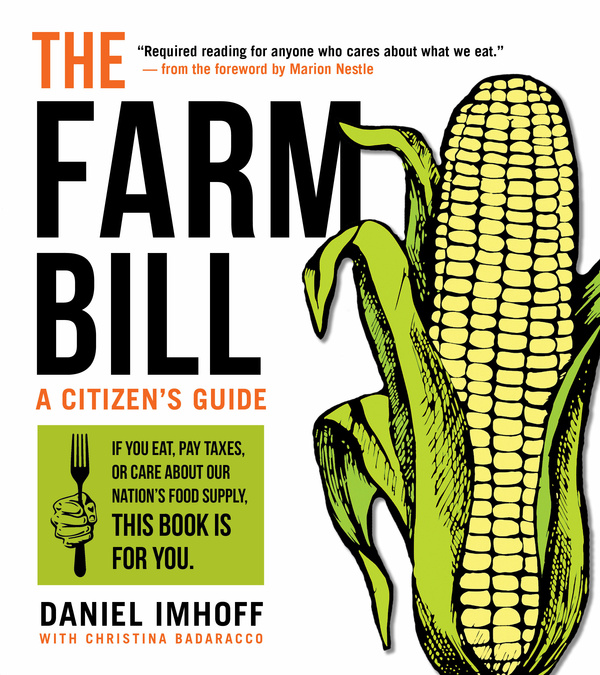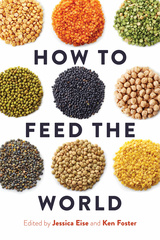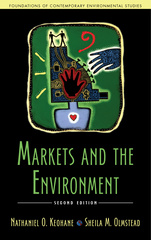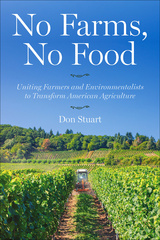The farm bill is one of the most important pieces of legislation the American president signs. Negotiated every five to seven years, it has tremendous implications for food production, nutrition assistance, habitat conservation, international trade, and much more. Yet at nearly 1,000 pages, it is difficult to understand for policymakers, let alone citizens. In this primer, Dan Imhoff and Christina Badaracco translate all the “legalese" and political jargon into an accessible, graphics-rich 200 pages.
Readers will learn the basic elements of the bill, its origins and history, and perhaps most importantly, the battles that will determine the direction of food policy in the coming years. The authors trace how the legislation has evolved, from its first incarnation during the Great Depression, to today, when America has become the world’s leading agricultural powerhouse. They explain the three main components of the bill—farm subsidies, food stamps or SNAP, and conservation programs—as well as how crucial public policies are changing.
With a new farm bill just signed into law, we all need to understand the implications of food policy. What’s the impact of crop insurance? How does SNAP actually work? What would it take to create a healthier, more sustainable food system? These are questions that affect not only farmers, but everyone who eats. If you care about the answers, The Farm Bill is your guide.
Readers will learn the basic elements of the bill, its origins and history, and perhaps most importantly, the battles that will determine the direction of food policy in the coming years. The authors trace how the legislation has evolved, from its first incarnation during the Great Depression, to today, when America has become the world’s leading agricultural powerhouse. They explain the three main components of the bill—farm subsidies, food stamps or SNAP, and conservation programs—as well as how crucial public policies are changing.
With a new farm bill just signed into law, we all need to understand the implications of food policy. What’s the impact of crop insurance? How does SNAP actually work? What would it take to create a healthier, more sustainable food system? These are questions that affect not only farmers, but everyone who eats. If you care about the answers, The Farm Bill is your guide.
Daniel Imhoff’s recently-published The Farm Bill: A Citizen’s Guide [is] a welcome and much-needed source for translating farm bill legalese....[it is] a thorough and navigable history of the farm bill...[that] hands readers the tools to take action.
Dan Imhoff does an extraordinary job of explaining an impenetrable bill with such clarity that we can't ignore the facts: that our current Farm Bill profoundly damages our organic farms, our environment, and our health. Just as extraordinary are the practical solutions Imhoff proposes for fixing the bill—humane policies that would support regenerative agriculture and our local farmers instead of tearing them down.
Cuts to the core of dozens of issues Congress wrestles with every four years, and gives citizens sage advice for making their voices heard in a debate too often dominated by Big Ag, Big Food, and Big Money.
A must-read for those who truly care about how they feed themselves and their families.
Readers will gain deep insight into the big barriers to Farm Bill reform, but also into the ripening opportunities for major change. Imhoff makes a strong case for why we should care and what it will take to transform policy.
Dan Imhoff is the go-to person if you want to know both details and the full sweep of the Farm Bill.
Dan Imhoff is the author of multiple books about the food system, including CAFO: The Tragedy of Industrial Animal Factories (winner of the Nautilus 2011 Gold Prize for Investigative Reporting), Farming with the Wild, and Farming and the Fate of Wild Nature (with Jo Ann Baumgartner). Christina Badaracco is a registered dietitian who writes regularly about food, agriculture, and public health.
PART I. Farm Bill Basics
Chapter 1. What is the Farm Bill?
Chapter 2. Why Does the Farm Bill Matter?
Chapter 3. Whom Does the Farm Bill Benefit?
Chapter 4. How Does the Farm Bill Work?
PART II. The History of Food Policy
Chapter 5. Origins of the Farm Bill
Chapter 6. The Changing Face of Agriculture
Chapter 7. The Changing Face of Hunger
Chapter 8. The Conservation Era
PART III. Key Policy Issues
Chapter 9. Crop Subsidies
Chapter 10. Nutrition, SNAP, and Healthy Eating
Chapter 11. Agribusiness versus Family Farmers
Chapter 12. Job creation
Chapter 13. Trade
Chapter 14. An Alternative System
PART IV. Reforming the Farm Bill
Chapter 15. Opportunities for Change
Chapter 16. Public Health
Chapter 17. Food Security
Chapter 18. Ethanol
Chapter 19. Energy and Climate Change
Chapter 20. Conservation
Chapter 21. National Security
PART V. The Future of Food Policy
Chapter 22. Ecosystem-Based Agriculture
Chapter 23. Local Food
Chapter 24. A Citizen's Farm Bill
Chapter 25. Twenty-Five Solutions
Chapter 26. A Vision of Sustainable Food
Appendix: Activist Tool Kits
Glossary
Select Bibliography
Notes
Chapter 1. What is the Farm Bill?
Chapter 2. Why Does the Farm Bill Matter?
Chapter 3. Whom Does the Farm Bill Benefit?
Chapter 4. How Does the Farm Bill Work?
PART II. The History of Food Policy
Chapter 5. Origins of the Farm Bill
Chapter 6. The Changing Face of Agriculture
Chapter 7. The Changing Face of Hunger
Chapter 8. The Conservation Era
PART III. Key Policy Issues
Chapter 9. Crop Subsidies
Chapter 10. Nutrition, SNAP, and Healthy Eating
Chapter 11. Agribusiness versus Family Farmers
Chapter 12. Job creation
Chapter 13. Trade
Chapter 14. An Alternative System
PART IV. Reforming the Farm Bill
Chapter 15. Opportunities for Change
Chapter 16. Public Health
Chapter 17. Food Security
Chapter 18. Ethanol
Chapter 19. Energy and Climate Change
Chapter 20. Conservation
Chapter 21. National Security
PART V. The Future of Food Policy
Chapter 22. Ecosystem-Based Agriculture
Chapter 23. Local Food
Chapter 24. A Citizen's Farm Bill
Chapter 25. Twenty-Five Solutions
Chapter 26. A Vision of Sustainable Food
Appendix: Activist Tool Kits
Glossary
Select Bibliography
Notes








